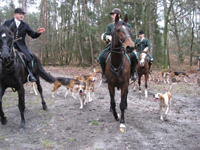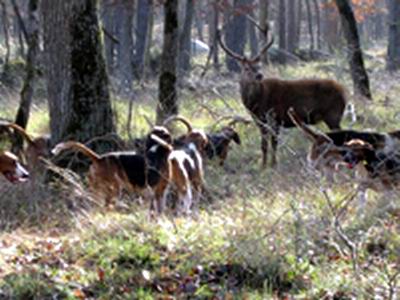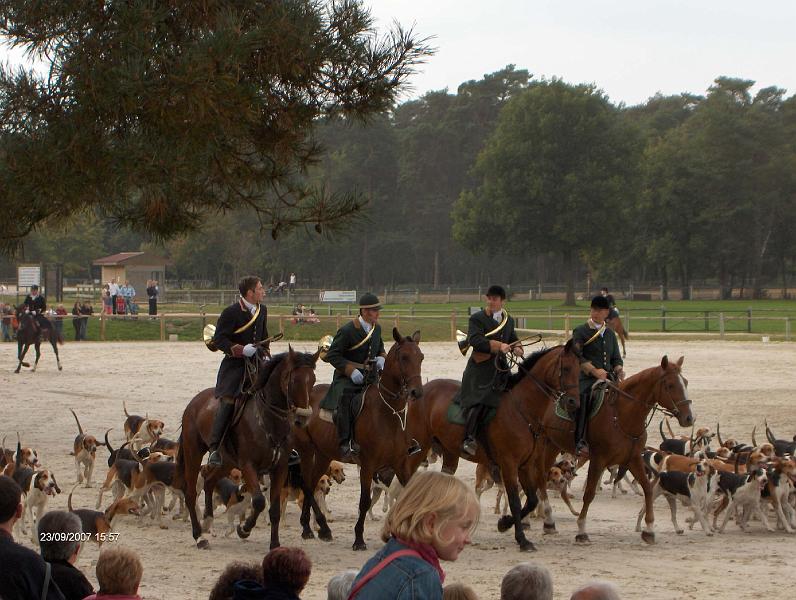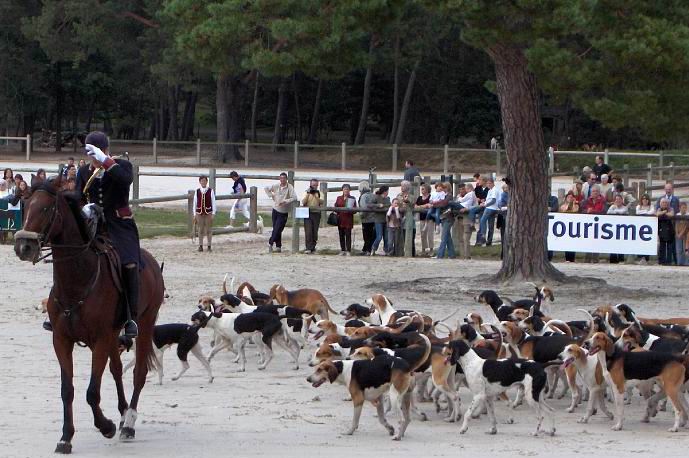Venery in Fontainebleau
-
Venery today
Translation from the Voix de la Forêt , centenary 2007 issue - Jacques SANDERS, Hunting Master , Rallye Fontainebleau.
 Lacking any personal opinion, the modern society nowadays trusts surveys... But you need no Gallup to imagine the answer to the following question: « do you believe that there exists still venery to hunt deers with hounds in the Fontainebleau Forest ? » If, instead asking Forest lovers you limit yourself to hurrying car drivers, Sunday hikers remaining on paved forest roads or city dwellers, the answer will be unanimously « No »... How is it possible to think that a place remains today, in such a wood welcoming millions of humans, by foot or by car, for great wildlife, typically associated with calm, mystery, and silence in remote, inaccessible or quasi-unviolated Forest ? And how to believe that such an old-fashioned and obsolete hunting mode as hunting with hounds, totally opposed to the time and the mood, would persist now in Fontainebleau, only 60 km far from Paris, like the old timer castle owners did centuries ago ? And yet…it’s the case !
Lacking any personal opinion, the modern society nowadays trusts surveys... But you need no Gallup to imagine the answer to the following question: « do you believe that there exists still venery to hunt deers with hounds in the Fontainebleau Forest ? » If, instead asking Forest lovers you limit yourself to hurrying car drivers, Sunday hikers remaining on paved forest roads or city dwellers, the answer will be unanimously « No »... How is it possible to think that a place remains today, in such a wood welcoming millions of humans, by foot or by car, for great wildlife, typically associated with calm, mystery, and silence in remote, inaccessible or quasi-unviolated Forest ? And how to believe that such an old-fashioned and obsolete hunting mode as hunting with hounds, totally opposed to the time and the mood, would persist now in Fontainebleau, only 60 km far from Paris, like the old timer castle owners did centuries ago ? And yet…it’s the case !
-
Adapt to environment
|
« To change everything so that nothing changes » ... This sentence said by Prince Lampedusa in the cult movie « Le Guépard » by Visconti, could very well apply to modern venery. To keep the essential, i.e. the principle of hunting with running hounds, venery had to adapt. After each troubled period of our history, venery in Fontainebleau has regained his former habits. But at the end of the 20th century, venery faced a very hostile context. First the sociological profile of the environment : numerous new owners of nearby houses do not tolerate that their weekend relaxing time be disturbed by a deer jumping in their garden followed by forty yelling hounds. Second, the media opposing to hunting with hounds, emphasizing complaints emanating from rare untoward hunting events, yielding an intolerant opinion against venery. Third, a deep change of the Forest itself due to the roads : the highway A6 cutting the Forest of the Trois Pignons in two parts, the National Road N7 being upgraded to 4 driving lanes with an impassable central wall. The continous rise of the road traffic considerably stresses and disturbs great wildlife in its everyday life and moves, especially to find food. Likewise, rising human hiking in the Forest interacts negatively with wildlife. Facing those problems, many have resigned, but fortunately a handful of resolute promoters of venery working together with the regional forestkeepers (ONF) like Gérard Tendron or Yves Richer de Forges, and by local mayors, especially the late Paul Séramy, have maintained the activity. Thus in 1978 Pierre Rayer, with the help of Edouard Fougea, could mount a hound team simply called "Rallye Fontainebleau". They were succeeded in 2005 by Charles Fougea, grandson of Edouard, and Philippe Dupuy. Through a strict ethical keep and a permanent watch this équipage has lasted until today and looks prospectively much more happily than before. |
|
|
|
In fact, the "Rallye Fontainebleau" has been successful by implementing specific local territorial constraints as well as national rules edicted by the French Society of Venery. So it has put itself in continuity with the rich Fontainebleau hunting history and the Forest context. It contributed actively to a big feast about 1000 years of Fontainebleau venery celebrated in 2002. What are those hunting constraints? First of all, the hunting mode: venery in a domanial Forest, only 60 km far from Paris, open to millions of visitors, has to be discreet and respectful of the quietness of the territory and of anybody in it. Thus hunting with hounds begins only in mid-October and ceases in mid-February, both sides a month less than ordinary hunting. For the same reason, the typical hunting days are Tuesday and Saturdays, in order to leave on Wednesdays the Forest free for young visitors. Likewise, hunting does not run on ferial days, hunters are asked to remain in their territory, the Forest, and to avoid to hunt in the inhabited areas; and even not to stay on the risky borders of the great roads.
|
-
Hunting yesterday and today.
|
Hunting with hounds has been practiced since 2 millenia, and reading the old hunting books one is forced to convene that very few things have changed in it. Actually the venery is centered around the hounds and the hunted animals, which have not changed at all. The role of man is to aid and guide the hounds, without hunting at their place, and the defensive instinct of the deers is eternal. The hunting records in the Fontainebleau Forest during the 18th and 19th centuries shows that the deers behave today exactly like before and take the same forest trails. Only the modern barriers (fences, wood cuttings, roads with dense car and truck traffic) modify the immutable wildlife ways. Venery keeps also proudly a set of traditions considered as an important part of our national legacy, including a special fixed language describing all hunting items.
|
-
The Rallye Fontainebleau in 2006 - 2007
|
A team for hunting with hounds is ever composed of three fundamental components: a territory, men (with or without horses) and hounds. |
The territory : |
|
At the beginning and at the end of each season, the team hunts a month in the Orléans forest. In between, the Rallye Fontainebleau hunts deers in the Fontainebleau Forest following adjudications by the Office National des Forêts (ONF). This territory represents 17000 hectares, the second in France, behind the Orléans’ forest.
|
The men: |
|
Thanks to Charles Fougea, taking at 40 years of age the place of Hunt Master in 2005-2006 after Pierre Rayer, who leaded 28 seasons of venery in Fontainebleau ; and to Philippe Dupuy , president of the association after Hubert Ghigonis, the Rallye Fontainebleau has taken a new start ten years ago, with renewing of its members, and coming of younger ones. So beneath old experienced hunters over 80 years old like Elisabeth Kneppert, Jeanine Pineau or Philippe Imbault, there are younger ones, even teenagers. The total team amounts 70 members stratified in various grades : "boutons", "gilets", "amis cavaliers" and "amis", coming either from the South Seine-et-Marne or from Paris.
|
The Hounds : |
|
The hounds are Anglo-French tricolors and Poitevins hounds, combining the qualities of tenacity, smelling and barking power. The total amount of the hounds is around 100. They stay since 1964 at the maison forestière de La Garenne Gros Bois, at the South border of the Fontainebleau Forest. Even if the hunt is done by the hounds and not the hunters, the hunters are training the hounds ; hence the importance of selection, breeding, training and dressage. Starting at no less than 18 months, the hunting hounds career lasts only until seven years of age maximum. The hounds go for training with trainers either by feet or riding horses, and run long distances in order to acquire a first-order athletic condition. This enables them to run kilometers by tens at each hunt, but they also have a rigorous dressage to attain a total obeyance to the Hounds Master as well as to the Hunter Master. In order to control at the best the whole group of hounds, the Hounds Master takes as a rule only 40 dogs for each hunt. |
 The Rallye Fontainebleau runs a website open to everyone in order to show its openness and willing to integrate best in the environment : http://www.rallyefontainebleau.com . Every dweller or user of the Fontainebleau Forest may gather there information, statistics and data about the hunt with hounds. The hunts are open to external people who can discover in the field the vitality and utility of Fontainebleau venery.
The Rallye Fontainebleau runs a website open to everyone in order to show its openness and willing to integrate best in the environment : http://www.rallyefontainebleau.com . Every dweller or user of the Fontainebleau Forest may gather there information, statistics and data about the hunt with hounds. The hunts are open to external people who can discover in the field the vitality and utility of Fontainebleau venery.
The venery’s vitality is proved by the preservation of an abundant cervid population in the Forest, although a second team hunting with hounds has formed since 10 years : the Rallye Tempête, hunting the roe. Website: http://equipage.tempete.perso.neuf.fr/RT_Equip.htm
|
So today in some cases two parallel hunts may run in different parts of the Fontainebleau Forest, without mixing since the big roads are walls to the animals and hounds. The Rallye Tempête has mounted, thanks to its leaders Marie-Hélène and Pierre-François Prioux, an annual Venery Feast at the Grand Parquet site. This is quickly become an unmistakable meeting of the venery lovers in Ile-de-France and a mediatic flashing symbol of the venery at Fontainebleau. |


